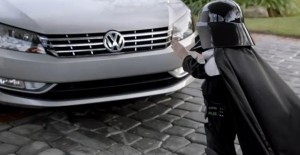Want A Good Ad? Conceal The Premise.
We’re all more or less familiar with the syllogism. The idea is that we can state premises – with certain rules – and draw conclusions that are logically valid. So we might say:

Cute. Must be a great car.
Major premise: All humans are mortal.
Minor premise: Travis is a human.
Conclusion: Therefore, Travis is mortal.
In this case, the syllogism is deemed valid because the conclusion flows logically from the premises. It’s also considered sound since both premises are demonstrably true. Since the syllogism is both valid and sound, the conclusion is irrefutable.
We often think in syllogisms though we typically don’t realize it. Here’s one that I go through each morning:
Major premise: People get up when the sun rises.
Minor premise: The sun is rising.
Minor premise: I’m a person.
Conclusion: Therefore, I need to get up.
I don’t usually think, “Oh good for me … another syllogism solved”. Rather, I just get out of bed.
We often associate syllogisms with logic but we can also use them for persuasion. Indeed, Aristotle identified a form of syllogism that he believed was more persuasive than any other form of logic.
Aristotle called it an enthymeme – it’s simply a syllogism with an unstated major premise. Since the major premise is assumed rather than stated, we don’t consider it consciously. We don’t ask ourselves, Is it valid? Is it sound? We just assume that everything is correct and get on with life.
Though they don’t use the terminology, advertisers long ago discovered that enthymemes are powerful persuaders. People who receive the message don’t consciously examine the premise. That’s exactly what advertisers want.
As an example, let’s dissect one of my favorite ads: the 2012 Volkswagen Passat ad featuring the kid in the Darth Vader costume. The kid wanders around the house trying to use “The Force” to turn on the TV, cook lunch, and so on. Of course, it never works. Then Dad comes home, parks his new Passat in the driveway, and turns it off. The kid uses the force to turn it back on. Dad recognizes what’s going on and uses his remote starter to start the car just as the kid hurls the force in the right direction. The car starts, the kid is amazed, and we all love the commercial.
So what’s the premise? Here’s how the ad works:
Major (hidden) premise: Car companies that produce loveable ads also
produce superior cars.
Minor premise: VW produced a loveable ad.
Conclusion: Therefore, VW produces superior cars.
When we think about the major premise, we realize that it’s illogical. The problem is that we don’t think about it. It enters our subconscious mind (System 1) rather than our conscious mind (System 2). We don’t examine it because we’re not aware of it.
Here’s another one. I’ve seen numerous ads in magazines that tout a product that’s also advertised on TV. The magazine ads often include the line: As Seen On TV. Here’s the enthymeme:
Major (hidden) premise: Products advertised on TV are superior to
those that aren’t advertised on TV.
Minor premise: This product is advertised on TV
Conclusion: Therefore, it’s a superior product.
When we consciously examine the premise, we realize that it’s ridiculous. The trick is to remind ourselves to examine the premise.
If you want to defend yourself against unscrupulous advertisers (or politicians), always be sure to ask yourself, What’s the hidden premise?